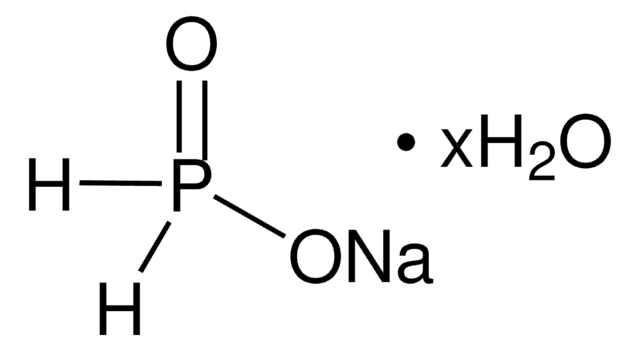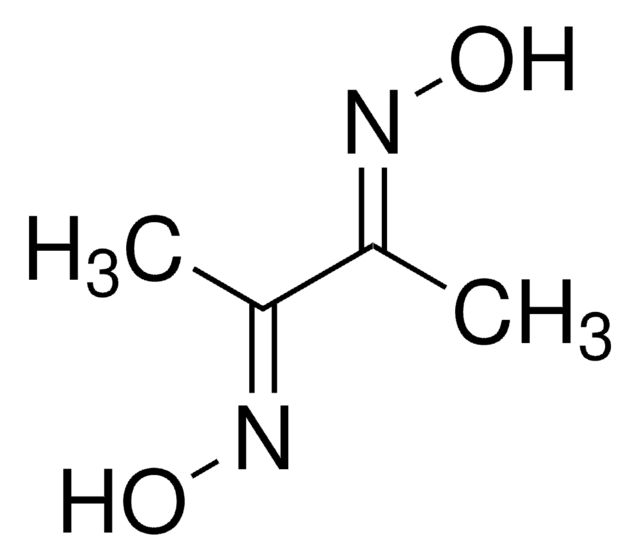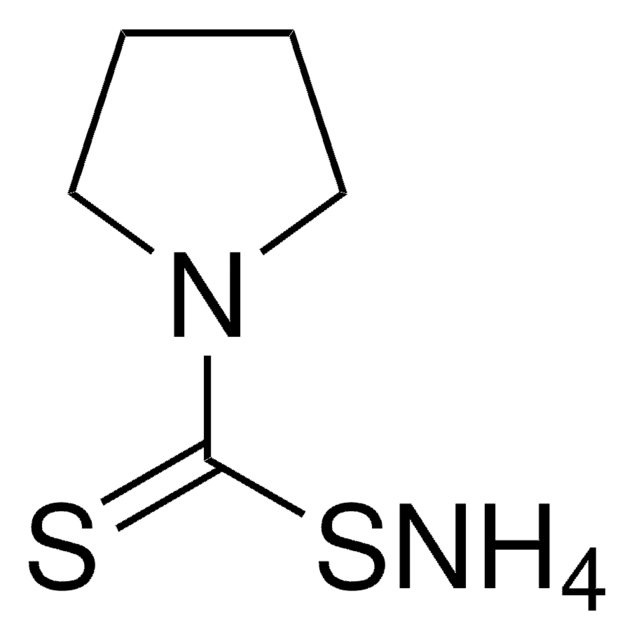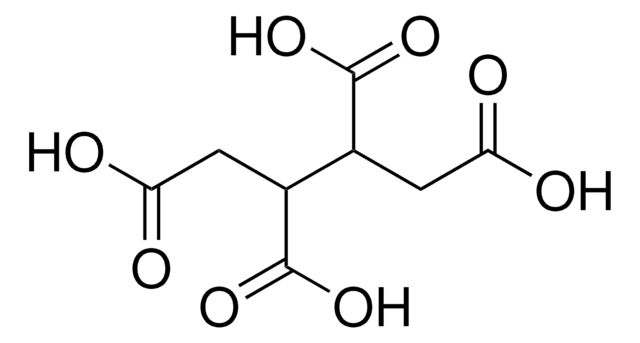04434
Sodium hypophosphite
puriss., meets analytical specification of BPC63, anhydrous, 98-101%
로그인조직 및 계약 가격 보기
모든 사진(1)
About This Item
Linear Formula:
NaPH2O2
CAS Number:
Molecular Weight:
87.98
EC Number:
MDL number:
UNSPSC 코드:
12352302
eCl@ss:
38070302
PubChem Substance ID:
NACRES:
NA.21
solubility:
water: soluble 909 g/L at 30 °C
추천 제품
grade
puriss.
분석
98-101%
양식
powder or crystals
품질
meets analytical specification of BPC63
불순물
≤0.001% heavy metals (as Pb)
≤0.2% free alkali (as CaO)
손실
≤1% loss on drying, 105 °C, 2 h
solubility
water: soluble 909 g/L at 30 °C
density
1.77 g/cm3 at 20 °C
음이온 미량물
chloride (Cl-): ≤200 mg/kg
sulfate (SO42-): ≤200 mg/kg
양이온 미량물
As: ≤2 mg/kg
Fe: ≤10 mg/kg
SMILES string
[Na+].[O-][PH2]=O
[Na+].[O-][PH2]=O
InChI
1S/Na.H3O2P/c;1-3-2/h;3H2,(H,1,2)/q+1;/p-1
InChI key
SIGUVTURIMRFDD-UHFFFAOYSA-M
유사한 제품을 찾으십니까? 방문 제품 비교 안내
관련 카테고리
일반 설명
Sodium hypophosphite, also known as sodium phosphinate, is a sodium salt of hypophosphorous acid. It is used as a reducing agent for the reduction of metal salts to metals in an aqueous solution. It is also employed as a source of hydrogen in heterogeneous catalytic transfer reductions.
애플리케이션
- Synthesis and characterization of chitosan-copper nanocomposites and their catalytic properties for 4-nitrophenol reduction.: This study explores the synthesis of chitosan-copper nanocomposites using sodium hypophosphite as a reducing agent. The resulting nanocomposites are characterized and their catalytic properties for the reduction of 4-nitrophenol are evaluated, demonstrating the utility of sodium hypophosphite in catalytic applications (Pang et al., 2024).
- The Durable Chitosan Functionalization of Cellulosic Fabrics.: This research focuses on the durable functionalization of cellulosic fabrics with chitosan using sodium hypophosphite as a cross-linking agent. The study highlights the improved properties of the fabrics, showcasing sodium hypophosphite′s role in textile enhancement (Flinčec Grgac et al., 2023).
- Hypophosphite cross-linked starch succinate/chitosan membranes as alternative for packaging and pharmaceutical application.: The study investigates the development of starch succinate/chitosan membranes cross-linked with sodium hypophosphite, proposing these materials as potential alternatives for packaging and pharmaceutical applications (Bajer, 2023).
- Tensile Strength Improvements of Ramie Fiber Threads through Combination of Citric Acid and Sodium Hypophosphite Cross-Linking.: This research improves the tensile strength of ramie fiber threads by combining citric acid and sodium hypophosphite for cross-linking, demonstrating significant enhancements in fiber properties for industrial applications (Wulandari et al., 2023).
- Nickel-Catalyzed Sodium Hypophosphite-Participated Direct Hydrophosphonylation of Alkyne toward H-Phosphinates.: This study demonstrates a novel nickel-catalyzed hydrophosphonylation of alkynes using sodium hypophosphite. The research showcases the efficiency of sodium hypophosphite in producing H-phosphinates, highlighting its significance in chemical synthesis (Qian et al., 2023).
Storage Class Code
13 - Non Combustible Solids
WGK
WGK 2
Flash Point (°F)
Not applicable
Flash Point (°C)
Not applicable
이미 열람한 고객
Reduction of carbon-carbon double bonds and hydrogenolysis by sodium hypophosphite.
Sala R, et al.
Tetrahedron Letters, 25(40), 4565-4568 (1984)
Rapid synthesis of copper nanoparticles by sodium hypophosphite reduction in ethylene glycol under microwave irradiation.
Zhu H-T, et al.
Journal of Crystal Growth, 270(3), 722-728 (2004)
Mohammad H Eskandari et al.
Food science & nutrition, 1(5), 392-401 (2014-05-08)
Nitrite-free and low-nitrite meat-curing systems were developed to eliminate or reduce nitrite in frankfurter-type sausages. Different composite meat-curing mixtures were formulated using cochineal and paprika as natural colorants, sodium hypophosphite (SHP) as antimicrobial agent, butylated hydroxyanisole (BHA) as antioxidant and
C Sánchez-Pedreño et al.
The Analyst, 115(9), 1257-1260 (1990-09-01)
A kinetic method for the determination of Te based on its inhibitory effect on the PdII-catalysed reaction between pyronine G and H2PO2- is described. The influence of experimental variables on the rate of the process and the potential interfering effect
W S Price et al.
Biophysical journal, 61(3), 621-630 (1992-03-01)
A new 31P NMR method is used to probe the cytoplasmic viscosity of human erythrocytes. The method is based on observing two-spin order relaxation of the 31P atom of the hypophosphite ion. This method is superior to our previous method
자사의 과학자팀은 생명 과학, 재료 과학, 화학 합성, 크로마토그래피, 분석 및 기타 많은 영역을 포함한 모든 과학 분야에 경험이 있습니다..
고객지원팀으로 연락바랍니다.










